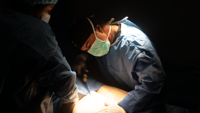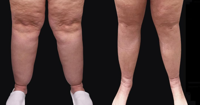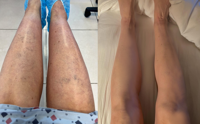
When Puerto Rican actress Eileen Navarro first noticed unusual swelling and bruising in her legs and arms, she assumed it was just part of life in the spotlight—long hours on set, tight costumes and high heels.
“My legs began to get bigger and painful, my arms felt like they were filled with rice,” said Navarro. “I noticed a ring around the ankles, my feet began to get darker, but overall, the pain was unbearable.”
In a panic, Navarro sought medical treatment, but like many women, Navarro’s symptoms were misread, misdiagnosed or dismissed entirely.
“It was always difficult to get the right diagnosis,” said Navarro. “All the doctors I saw would tell me that I was just getting fat or that I was obese.”
Navarro’s doctors eventually misdiagnosed her with Elephantiasis–a disease caused by parasitic worms transmitted through mosquito bites, resulting in severe swelling due to damage to the lymphatic system.
“I lived with that diagnosis for six years, and then I found out it was lipedema,” said Navarro. “I was living with stage 4 lipedema.”
After years of living with an incorrect diagnosis, Navarro met with Dr. David Amron, founder and medical director of The Roxbury Institute, where she was diagnosed with lipedema–a chronic fat disorder that disproportionately affects women and is often misunderstood.
“I was referred to cases that nobody was touching, such as calves, ankles and forearms,” said Dr. Amron. “There were no papers on it, there was no information about these areas often associated with lipedema, and I had to figure it out myself.”
The Lipedema Project explains that the condition progresses over four stages, with Stage 4 being severe.
Dr. Amron has over 30 years of experience in the field of liposuction, lipedema and fat disorders. He remains a leading medical professional in caring for this complex condition, which he says affects over 17 million women in the United States, adding that globally, one in nine women are living with lipedema–the same rate as breast cancer.
Lipedema experts say the condition shows up in the body with pain, tenderness, easy bruising and swelling, often accumulating fibrotic fat on the legs, buttocks and arms. The cause is still very misunderstood, but it is reported that lipedema tends to start or worsen during puberty and other periods of hormonal changes, such as pregnancy and menopause.
Despite its high prevalence, lipedema is rarely diagnosed early, particularly among Latinas and other women of color. Celebrities like Kelly Clarkson, Wendy Williams and Shaughna Phillips have openly discussed their experiences with lipedema.
“There is no blood test for it; it’s a clinical diagnosis,” said Dr. Amron. “Patients are commonly self-diagnosing or hearing of the term because they are seeing more of it on social media.”
According to The Lipedema Foundation, lipedema is “a poorly understood disease,” and the “knowledge gap is largely due to inadequate studies of epidemiology.”
“It begins to cosmetically affect things, but then it affects things with your lifestyle,” said Dr. Amron. “Many times, there’s a lack of energy from the inflammation, mobility can be affected, they get more winded or [there’s] more pain in their legs. Some patients even develop orthopedic issues.”

The little research that has been done highlights an underlying issue: women who are diagnosed with lipedema are diagnosed at later stages of the condition. Proper diagnosis and treatment for lipedema can prevent or slow the progression, help retain mobility and decrease pain.
Lipedema studies conducted by the National Institute of Health found that approximately 70% of the women surveyed had experienced lipedema onset before age 30, and less than 2% had been diagnosed by a healthcare professional before that age.
For Navarro, the diagnosis came years after she’d already been quietly unraveling. “I was in pain constantly—not just physically, but emotionally,” she says. “And no one could tell me what was wrong.”
While there's no cure, lipedema treatment has evolved over the years to offer numerous approaches. Some aim to remove fat deposits, while others target symptoms. These options include compression garments, manual lymphatic drainage and targeted liposuction.
“There’s one particular photo with Dr. Amron after my first surgery that I got from him where it captured me crying because for the first time after 13 years, I was able to see my ankles,” said Navarro. “We need to take women with lipedema seriously. We think that treatment for lipedema is aesthetic, and it’s not.”
In addition to physical symptoms, lipedema can also affect an individual’s mental health and quality of life, sometimes leading to feelings of hopelessness, low self-esteem or eating disorders.
Navarro, known for her work in Puerto Rican telenovelas, film and theater—and for performing alongside stars like Chayanne and Giselle Blondet—soon found that her changing body no longer “fit the roles” casting directors sought.
“I’ve been in this industry for quite some years, and it was very difficult for me as an actress,” said Navarro. “People know you and you hear the gossip. My family left me. I had to constantly deal with these surroundings. It made me feel like I wanted to die.”
At her lowest point, Navarro considered taking her own life. “I truly believed I was broken beyond repair,” she says. “I thought I’d never feel like myself again.”
Navarro went public about her struggles in 2019 with her lipedema diagnosis, the depression caused by abandonment by her family and a negative economic situation.

Dr. Amron will release a research-backed supplement line early this summer to support those living with lipedema.
“We have a really comprehensive program, not only just surgically, but preventatively for Lipedema,” said Dr. Amron. “We're expanding into other areas to serve this community, such as vein therapy and physical therapy for lipedema patients.”
Currently, Dr. Amron is working to get The Lipedema Society off the ground, a non-profit that will advocate for lipedema patients, offer certifications for surgeons who want to specialize in these treatments, and work with insurance companies to help patients cover the cost of treatment.
In the wake of her diagnosis and recovery, Navarro could have chosen to retreat quietly. Instead, she chose to speak up—determined to ensure no one else would suffer in silence like she did.
Navarro is set to return to the stage in November in “La Dama Del Teatro”(“The Lady of The Theatre”), a monologue that deals with a fading actress who ends in demise.
“I’m me again. I’m working,” said Navarro. “They will see my scars, they will see everything and I want them to look at them.”











(0) comments
Welcome to the discussion.
Log In
Keep it Clean. Please avoid obscene, vulgar, lewd, racist or sexually-oriented language.
PLEASE TURN OFF YOUR CAPS LOCK.
Don't Threaten. Threats of harming another person will not be tolerated.
Be Truthful. Don't knowingly lie about anyone or anything.
Be Nice. No racism, sexism or any sort of -ism that is degrading to another person.
Be Proactive. Use the 'Report' link on each comment to let us know of abusive posts.
Share with Us. We'd love to hear eyewitness accounts, the history behind an article.